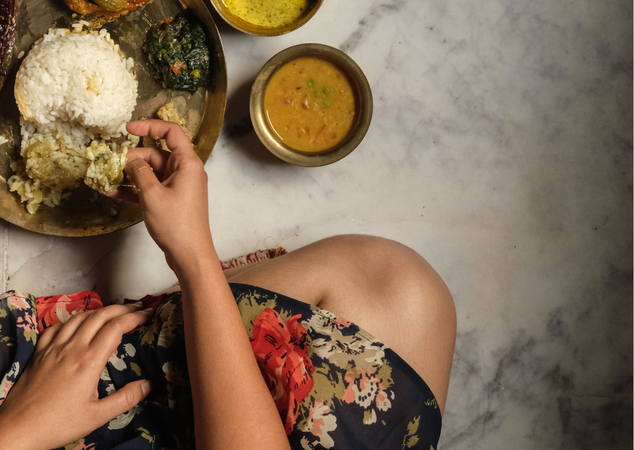|
Currently, I am immersed in the vibrant culture of incredible India. I've had the pleasure of indulging in sumptuous curries ranging from meat to vegetables, grains and pulses using the age-old tradition of eating curry with one's fingers as I travel India or known locally as Bharat ( derived from the Sanskrit name for the country.) I've embraced the centuries-old motto and tweaked it a little, 'When in India, do as the Indians do.' I've found myself eschewing utensils in favour of the tactile connection afforded by using my fingers. It's a practice that prompted a deeper reflection on the origins of utensil use. The act of eating with one's hands also has historical and utensil-usage implications. In the book ‘Feeding Desire: Design and the Tools of the Table, 1500-2005’ Coffin et al. explains that utensils like knives, forks, and spoons have enriched our dining experiences by acting as extensions of our hands, suggesting an evolution from direct hand-to-food to changes in dining etiquettes and experiences over centuries. Before Using Your Hands Eating with your hands is not just a cultural norm, it's an integral part of the dining experience. Using your fingers to scoop up flavourful curries with rice or bread connects you more intimately with the food and heightens the sensory experience. Before you start, most restaurants will make a basin available in the dining room to wash your hands. Traditionally, you will use your right hand to eat, as the left hand is considered unclean. How To Eat With Your Hands
Bread, known as roti, naan, paratha, chapati, and the list goes on, are just a few examples of the diverse array of breads found in Indian cuisine, each with its unique texture, flavour, and cooking method. These breads are central to Indian cuisine, serving as the perfect accompaniment to curries that could contain lentils or chickpeas, and grilled meats. They are my favourite accompaniment to an Indian meal. I use two techniques. One is to tear the bread and pick up the ‘dry’ curry with the bread. The second is to fold the bread in a cone shape to pick up the ‘wet’ curries. Another way to eat curry is with rice. Depending on what part of India you are in, rice will vary from basmati to laal chawal, laal meaning red. You will be given a large serving of rice with various curries surrounding it. Find a clean space on your thali plate to scoop up a small portion of rice and curry. Mix the curry with the rice using only your fingertips, not the whole hand. This is done so the curry is absorbed into the rice, ready for you to eat and enjoy. Gently picking up the mixed food with your fingers, shape the rice and curry into a small bite-sized portion. Push the bite of food into your mouth by sliding the food down your fingers levered by your thumb. Be careful not to let your fingers touch your lips. I hope this information is helpful to you. It’s always good to try to do as the locals do. It helps ensure that your culinary experiences in India are conducted with cultural sensitivity and authenticity. Article Published By: Etiquipedia.blogspot.com
0 Comments
In the fast-paced world of corporate leadership, professional attire often speaks volumes about one’s approach to business. Two prominent figures, Sergio Ermotti, the Chief Executive of UBS Bank, and Elon Musk, the visionary behind Tesla and SpaceX, epitomise contrasting styles in the workplace. Ermotti, the top earner among European bank executives in 2023, opts for the classic suit and tie ensemble, symbolising professionalism and credibility. On the other hand, Musk, known for his innovative spirit and casual demeanour, often prefers the relaxed look of smart casual attire. While Ermotti adheres to tradition, favouring the timeless appeal of a tailored suit, Musk challenges conventions by embracing a more laid-back aesthetic. The contrast between the two figures sparks a conversation about the role of attire in projecting leadership image and corporate culture. Know the Dress Code: Research or inquire about the dress code for the meeting. Different industries and companies might have varying levels of formality. If unsure, it’s better to be slightly overdressed than underdressed. Jeans, sneakers, t-shirts, and overly casual attire should be avoided unless explicitly mentioned in the dress code. Choose a Well-Fitting Outfit: Opt for a suit in a neutral colour like navy, grey, or black. Pair it with a dress shirt, a conservative tie, and polished black dress shoes. Ensure that the suit is tailored to fit you properly. Wearing an ill-fitting suit that is overly large or too skintight can have people second-guessing you. Your local department store will have a tailor that will assist you in shaping the suit correctly to your body shape and length. Colours and Patterns: When it comes to colour, colour matters. Researchers from various universities in Ghana found that Thai Airways leverages the rich hue of purple as its brand colour, royalty and luxury. This choice is deliberate, aiming to create a perception of comfort and refined travel for their passengers. How can we apply this to business wear? Stick to classic and subdued colours such as navy, grey, black, and white. Black invoking prestige and power, blue eliciting notes of conservativism, and trustworthiness and grey conjuring the idea of security and balance. If you choose to wear patterns, keep them subtle. Avoid loud or flashy designs that might distract. If you want to add a splash of colour…why not wear a pair of coloured socks!
Grooming and Hygiene: Ensure your hair is neat and well-groomed. Maintain good personal hygiene, including clean nails and fresh breath. Good grooming displays attention to detail, health and respect for oneself. Avoid heavy perfumes or colognes. Strong scents could set off allergies and induce headaches. Accessories: Keep accessories minimal and tasteful. A watch, simple jewellery, and a belt can add a touch of sophistication. Avoid excessive jewellery or large colourful accessories. Research completed by academics David A. Ellis and Rob Jenkins found that watch wears showed ‘higher levels of consciousness’ and did turn up to appointments on time. Although time is displayed on our mobiles, wearing watches still has advantages! Footwear: Choose closed-toe dress shoes that are clean and polished. Never wear brown shoes unless you own your country farm and drive a tractor. Remember, when people glance at you, they look from top to bottom and behind! So be aware of your shoes, especially, the heel counter, making sure it is clean and free from splashes and dust. Appropriate Bag or Briefcase: Carry a business bag or briefcase that is slim and dark in colour to hold your documents and any necessary materials. Please ensure your bag is in good condition and complements your overall look. Never overfill your bag or load yourself up like a camel. The more you carry with you, the less professional you look. Confidence and Comfort: Choose an outfit that makes you feel confident and comfortable. Your comfort will contribute to your overall demeanour during the meeting. Remember, the goal is to present yourself as a professional who takes the meeting seriously. While most of us are not CEOs, even chief executive officers adhere to these guidelines, either personally or through their stylists, which underscores the importance of tailoring your attire to fit the culture and expectations of your industry and company. Remember, when uncertain, it’s always wise to lean towards professionalism, ensuring you make a positive and respectful impression in any professional setting. Article Published By: Luxury Adviser My boss requested that I speak at a Rotary breakfast, network, and present the business offerings. At the time, I worked in human resources. I didn’t think much about it and thought I could go and just present! I got there and started to get a little nervous. I remember being chosen first. It started strongly in the first 30 seconds, then went downhill. Despite the warm reception from the Rotary members, the experience underscored a critical lesson: effective presentation skills are indispensable. Focus On Core Message – “For any great communicator or leader, storytelling is essential. Stories allow us to visualize, empathize, and connect like statistics never could.” – Simon Sinek. Great communicators, like Simon Sinek, say facts and figures only get you so far. You want to create interest. You will want to capture attention by using a story piques the audience’s interest. You could use a new item, your own experience or a question. Powerful stories tap into our emotions and imagination. They let us experience something firsthand, making us more likely to remember, care, and take action – much more than dry statistics ever could. Crafting Your Message For Your Audience – I’d appreciate it if you could write down why you are there, what people expect you to talk about, and the problem you are solving for them. Once you have this, you can start crafting your main message. Your audience is there to gain valuable insights and solutions. They expect you to address their challenges and equip them with knowledge or tools to improve their situation. Your message should have an introduction, middle and conclusion. It doesn’t matter if your talk is less than five minutes or half an hour. The talk should expand on what you are ‘presenting’ and can help them personally. Picture Conversational Manner – To help dampen nerves, it’s best to write your talk out and practice repeatedly entirely. Record yourself and listen to it or send it to a trusted friend to evaluate it. It’s best to remember the talk rather than reading it off your phone or paper. Practising it will help you remember the key points and then insert your personality into it, creating a conversational manner with your audience.
Body Language – Developing stage presence can be intimidating at times. Here are a few tips to help you relax. Do specific research on those in the media, turn off the sound and watch their body language…what did you note? Their facial expressions? Hand placement? Body positioning? Good speakers will show open body language. At the same time, you speak, smile, and make eye contact, moving your head occasionally from one side of the room to the middle and then to the other. Hands are contained and moving with the body. “Body language is the unspoken part of communication that we use to reveal our true feelings and to give our message more impact. Communication is made up of so much more than words. Nonverbal cues such as tone of voice, gestures and posture play their part.” – Mindtools.com. The Powerpoint Presentation 10-20-30 Rule – After sitting through hundreds of pitches, Guy Kawasaki, marketing guru, entrepreneur and former Apple brand ambassador, surmised that when using PowerPoint, use the 10/20/30 Rule. What is this exactly? You can use ten slides. Using more than that can overload your listener, especially when pitching. Twenty minutes should cover the display of the slides. If you give an hour’s appointment, make leeway for those who are late, need to use the restroom or make urgent calls. Your PowerPoint slides should contain a thirty-point font, so you are only typing in the main points and filling in the minor issues while speaking. That Rotary breakfast became a turning point. The experience highlighted the importance of preparation, even for seemingly casual presentations. Since then, I’ve learned that I always appreciate the power of a well-crafted message and audience engagement. Article Published By: Luxury Adviser |
AuthorElizabeth Soos Archives
August 2025
Categories |
|
CONTACT US Submit Your Enquiry |





 RSS Feed
RSS Feed

